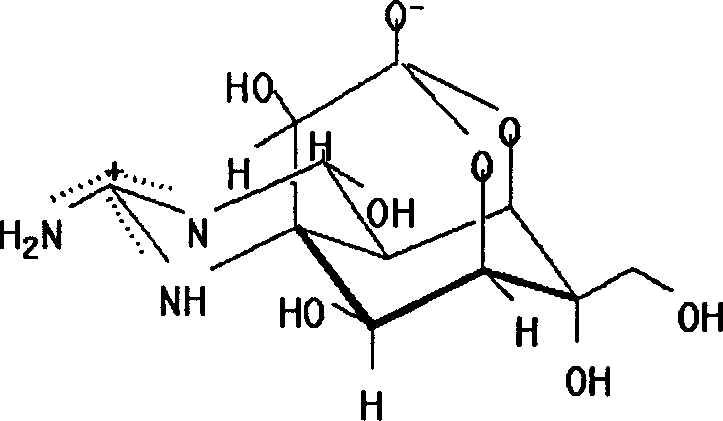Preparing derivative of tetradotoxin and application for giving up drug habits and easing pain
A technology of tetrodotoxin and derivatives, applied in the direction of drug combination, drug delivery, pill delivery, etc.
- Summary
- Abstract
- Description
- Claims
- Application Information
AI Technical Summary
Problems solved by technology
Method used
Image
Examples
Embodiment 1
[0034] (1) preparation of tetrodotoxin tartrate:
[0035] Take 100mg of tetrodotoxin (0.31mN), dissolve it in 1.0ml of hot distilled water (40-60°C), add tartaric acid equal to mN, fully ultrasonically vibrate the solution to make the solution in a fully dissolved state, let it rest for a few minutes, and concentrate under reduced pressure to 0.3- 0.5ml, stand still in the refrigerator at -5 to 5°C to form crystals, or directly concentrate under reduced pressure to obtain white crystals.
[0036] (2) preparation of tetrodotoxin maleate:
[0037] Take 100mg of tetrodotoxin (0.31mN), dissolve it in 1.0ml of hot distilled water (40-60°C), add maleic acid equal to mN, fully ultrasonically vibrate to make the solution in a fully dissolved state, stand still for several minutes, and concentrate under reduced pressure to 0.3-0.5ml, stand in a refrigerator at -5 to 5°C to form crystals, or directly concentrate under reduced pressure to obtain white crystals.
[0038] (3) preparation...
Embodiment 2
[0052] Embodiment 2: the analgesic activity of tetrodotoxin tartrate injection
[0053] (1) Tail-flick analgesic experiment in rats
[0054] Rats were randomly divided into four groups, ♂♀ half and half each, 8 rats in each group. They fasted for 12 hours before the experiment and had free access to water. With a constant temperature water bath at 55±1°C as the heat-induced pain source, after the rats were fixed, they were placed in hot water 5 cm above the tip of their tails, and the reaction time from when the tails of the rats entered the water to when they were thrown out of the water was recorded. Select the rats before the test: measure 3 times at intervals of 5 minutes, and select the rats whose tail-flick reaction time is within 3-7s for the test. During the test, 30 minutes after s.c administration, the tail-flick reaction time was measured, and the analgesic effect was defined as the tail-flick reaction time after administration was more than twice that before admi...
Embodiment 3
[0098] Embodiment 3: detoxification activity and dependence test of tetrodotoxin tartrate injection
[0099] The physical dependence test of tetrodotoxin tartrate injection was carried out with 3 kinds of animals and 5 kinds of models. The results showed that two dosage groups of tetrodotoxin tartrate injection were administered to rats and mice s.c. Rats were urged to jump and rats were urged to withdraw from the test. Compared with the morphine control group, the mice did not have a jumping response, and the rats did not appear to have a significant withdrawal response and weight loss; the rat group continued to be administered at a constant dose until the 22nd day. Withdrawal test, observed for 4 days after stopping the drug, no significant weight loss or other withdrawal reactions were observed, and the i.m. Morphine-like withdrawal symptoms and weight loss developed. These results show that the drug does not have physical dependence on opioids, suggesting that the drug w...
PUM
 Login to View More
Login to View More Abstract
Description
Claims
Application Information
 Login to View More
Login to View More - R&D
- Intellectual Property
- Life Sciences
- Materials
- Tech Scout
- Unparalleled Data Quality
- Higher Quality Content
- 60% Fewer Hallucinations
Browse by: Latest US Patents, China's latest patents, Technical Efficacy Thesaurus, Application Domain, Technology Topic, Popular Technical Reports.
© 2025 PatSnap. All rights reserved.Legal|Privacy policy|Modern Slavery Act Transparency Statement|Sitemap|About US| Contact US: help@patsnap.com



